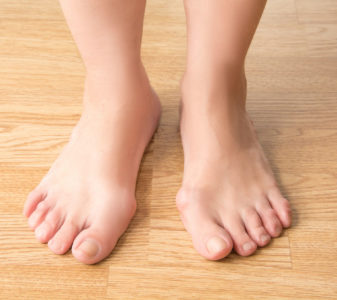 Bunions are one of the most common foot conditions we see in our office. They often develop due to foot genetics and footwear choices that put abnormal stress on our toe box. While a lot of people end up developing bunions, there doesn’t seem to be a lot of collective knowledge about the condition and how it is best treated. Below, we look to separate myths from truths when it comes to bunion treatment.
Bunions are one of the most common foot conditions we see in our office. They often develop due to foot genetics and footwear choices that put abnormal stress on our toe box. While a lot of people end up developing bunions, there doesn’t seem to be a lot of collective knowledge about the condition and how it is best treated. Below, we look to separate myths from truths when it comes to bunion treatment.
Myths and Truths About Bunion Surgery
1. Bunions can be treated without surgery.
Answer – True. Bunions can be successfully treated without surgery if they are caught in their infancy. By noticing the beginning signs of a bunion and taking some corrective measures, you can prevent it from turning into a bunion that needs a surgical operation. If you begin to notice an asymptomatic bunion growing on the side of your big toe joint, talk to a foot specialist about what types of footwear to consider, and if orthodics or bunion padding should be used.
2. Bunion surgery is very painful.
Answer – False. The surgical site is numbed during the procedure, so there’s very little discomfort during the procedure. There may be a little more pain when you’re recovering, simply because the area will get a lot of blood flow, but this can often be easily managed with simple medications. Any discomfort surrounding the operation is usually well worth the end result.
3. There’s one type of bunion surgery.
Answer – False. Depending on the severity of your bunion, your doctor may recommend one of a few different procedures. There’s bunion shaving, which involves shaving down the excessive bone on small bunions. There’s also bone cutting, in which the big toe joint is repaired and realigned to fix the problem and prevent it from coming back. Finally, there’s joint fusion, in which the joint is fused to prevent it from continuing to shift out of place. Your surgeon can explain which minimally invasive operation is best for you.
4. Once treated, bunions won’t come back.
Answer – False. Bunions can come back if you don’t also consider some lifestyle modifications. The easiest change is to wear comfortable shoes with a wide toe box to get the joint plenty of room. If you go back to doing the same things you were doing before the bunion began, there’s a decent chance you’ll have to deal with another bunion down the road.
5. You can get back to physical activity right away after bunion surgery.
Answer – False. Full recovery from bunion surgery can take a couple of months, but it’s worth it to ensure the joint is ready to handle the rigors of physical activity. Check out this testimonial from Kate about how she was able to recover in time for her soccer season. She said she knows people who rushed back to activities and have had lingering pain issues, so it’s worth it to wait until you are fully healed to begin sports.
6. Bunion surgery has high success rates.
Answer – True. Corrective bunion surgeries have very high success rates, but those rates can dip if patients don’t adjust their lifestyle to prevent recurrence, or they jump back into activity too quickly after surgery. Dr. Silverman has successfully corrected countless bunions, and he can do the same for you while also setting you up with a rehab plan to ensure you make a full recovery.